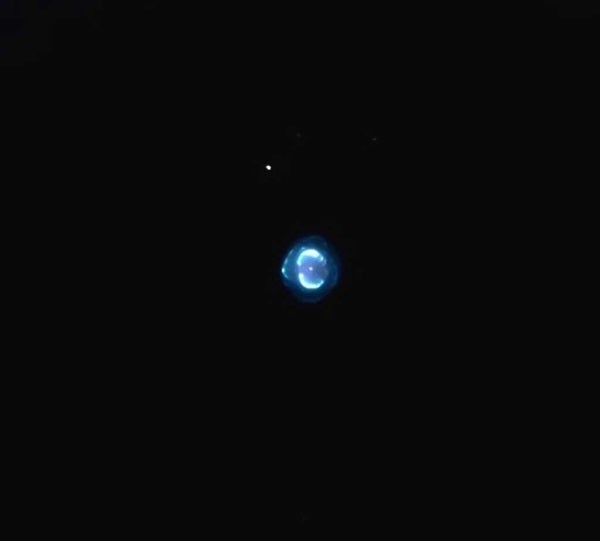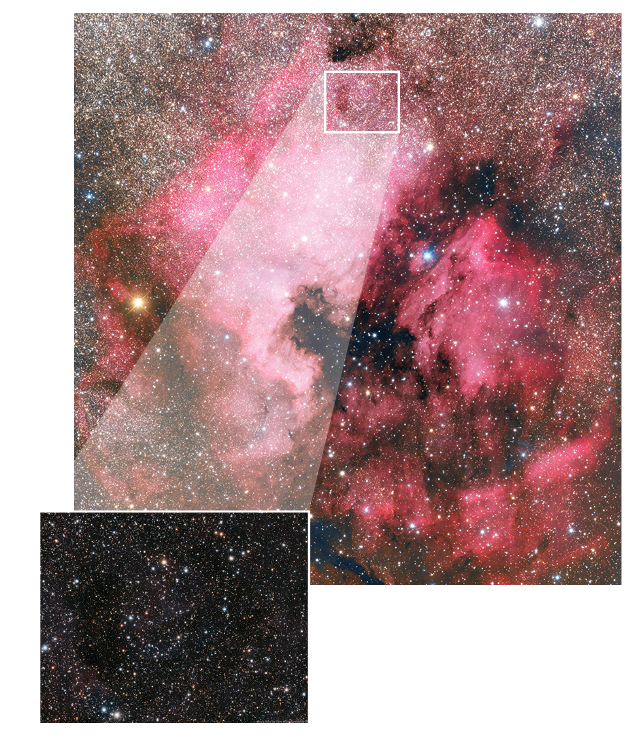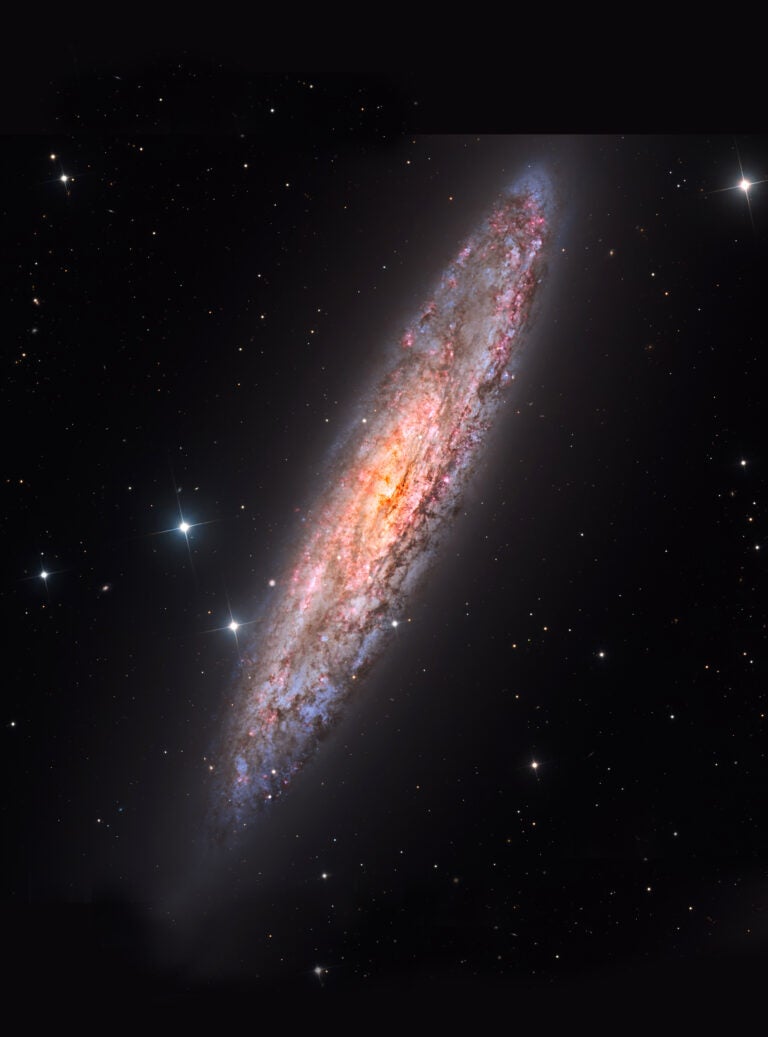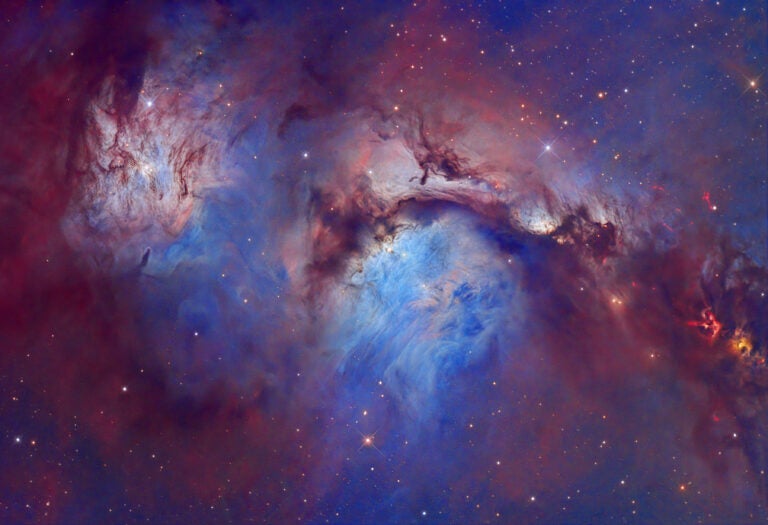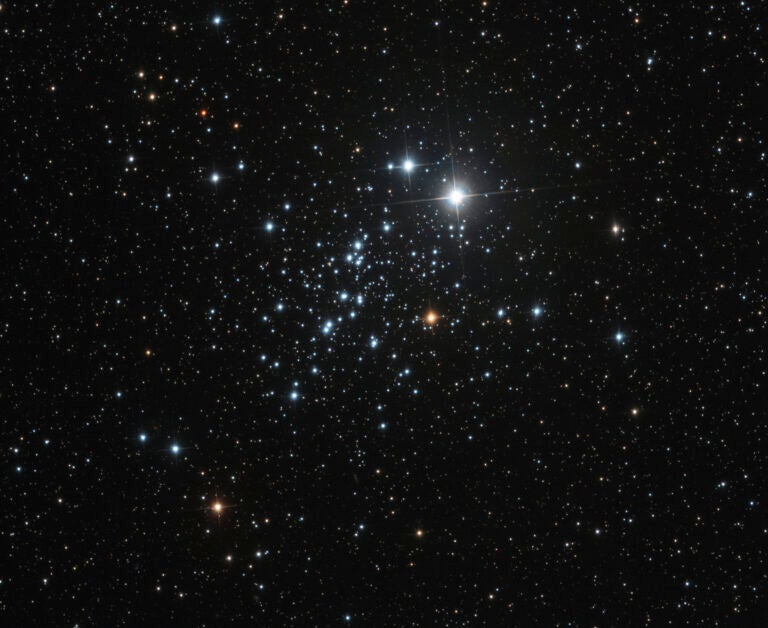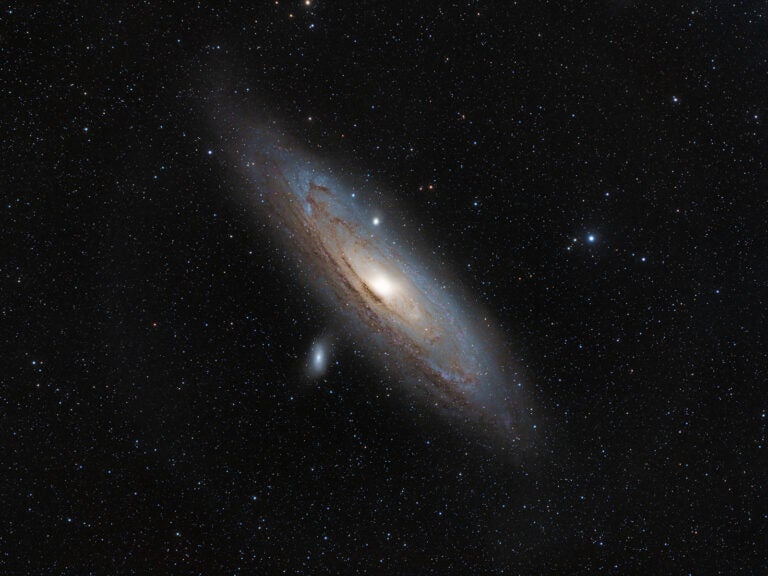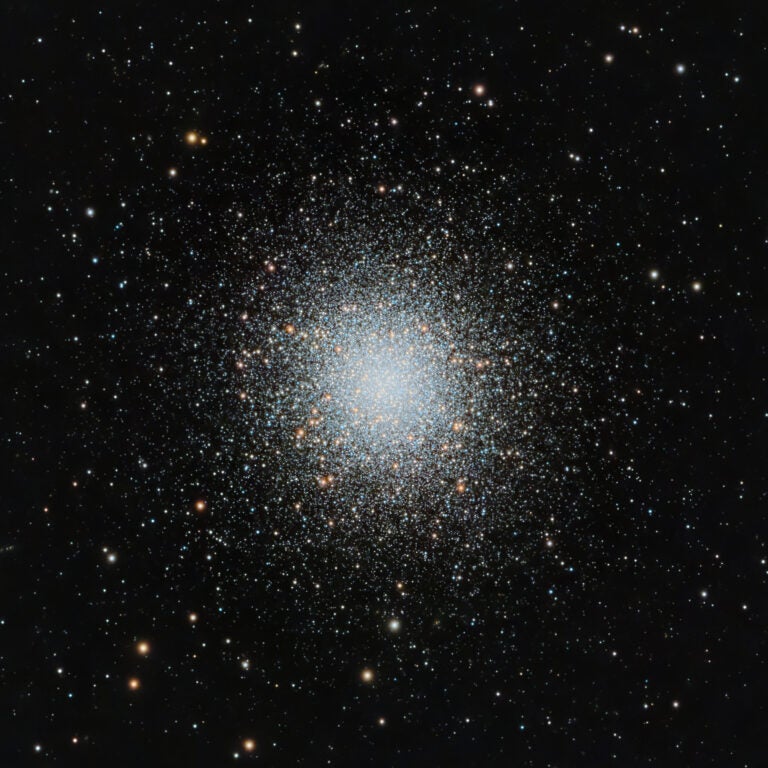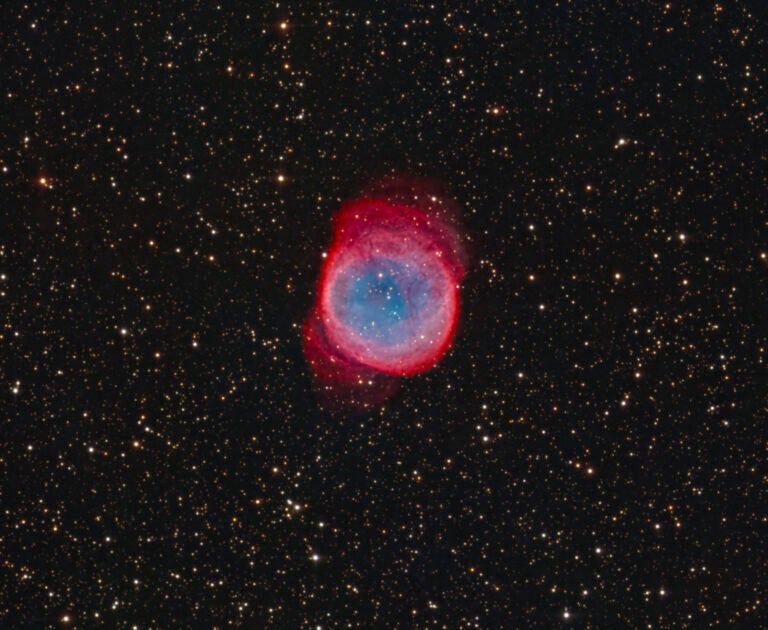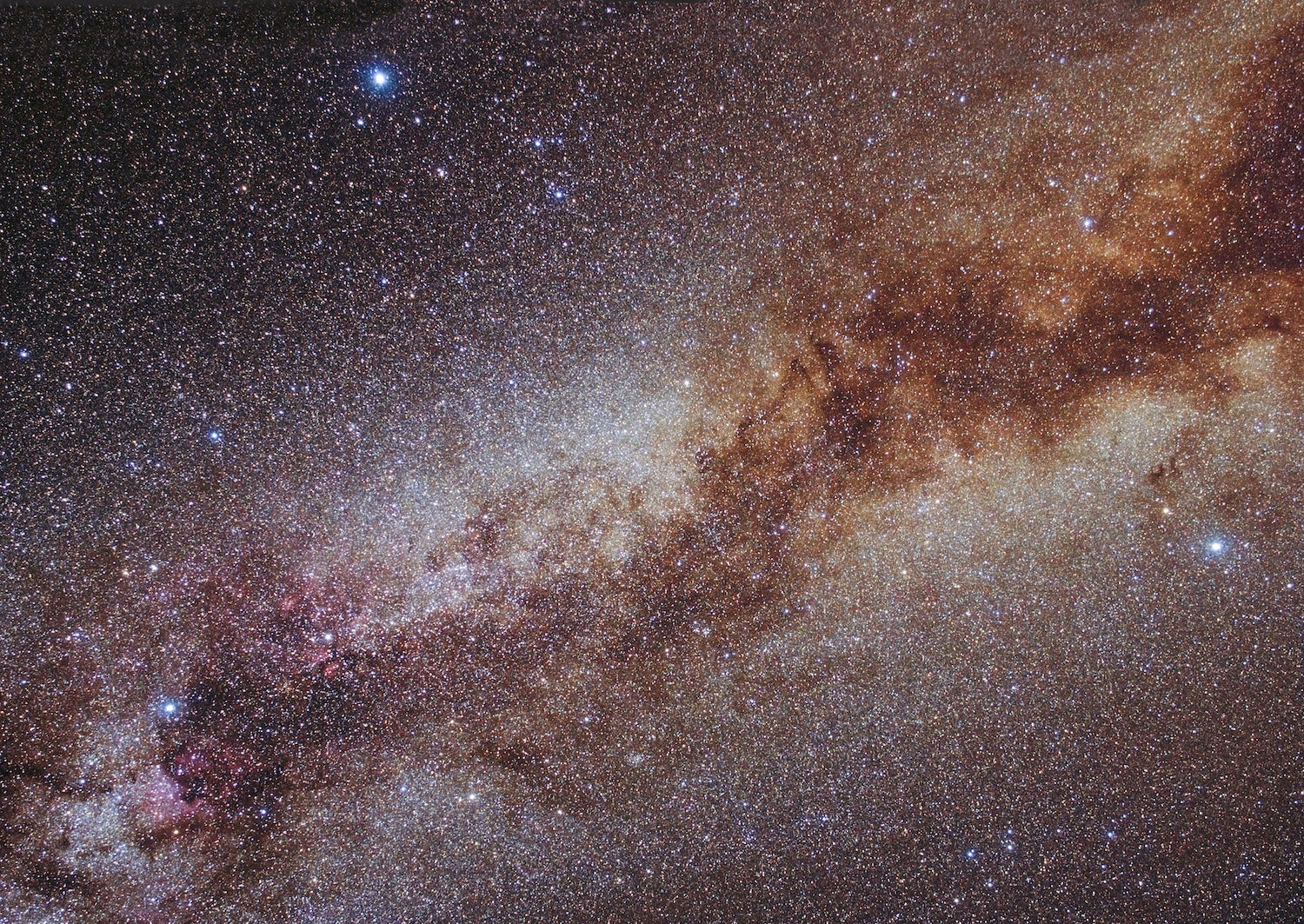
Asterisms are a group of stars with similar brightness that form a recognizable shape or pattern but don’t define a specific constellation. Among the Northern Hemisphere’s best-known asterisms are the Big Dipper and Little Dipper, the Square of Pegasus, and the Summer Triangle.
The Summer Triangle, which rides high overnight at this time of year, holds great interest for observers. This large asterism covers an area of roughly 415 square degrees — more than 2,000 Full Moons would fill it. Its points are marked by Vega in Lyra, Deneb in Cygnus, and Altair in Aquila. Each is bright enough to see under light-polluted skies (magnitudes 0, 1.3, and 0.8, respectively). In addition to the constellations housing those anchor points — Cygnus, Aquila, and Lyra — portions of Sagitta and Vulpecula also lie within the asterism.
If you venture out of the city and find dark skies, you will see that the Summer Triangle’s interior is filled with the rich star field of the Milky Way, including the Cygnus Star Cloud, one of the brightest portions of the Milky Way in the Northern Hemisphere. The Great Rift, a complex of dust clouds, stretches diagonally through the Summer Triangle like a dark zipper.
The three bright stars that form this large celestial triangle have been known for millennia. The name “Summer Triangle” is a fairly recent creation, though, coined in the 1930s by Austrian astronomer Oswald Thomas as Sommerliches Dreieck. And the term didn’t become widely used until two decades later, when it was popularized by British astronomer Sir Patrick Moore and German-American author H.A. Rey. (Though best known for the Curious George books, Rey also redrew constellation diagrams to make them more intuitive in his 1952 The Stars: A New Way to See Them.)
Viewed with binoculars, the Summer Triangle reveals nebulae, clusters, and irregular groups of stars to make the region an observer’s paradise. Open clusters are concentrated in the disk of the Milky Way, especially near the galactic plane, our galaxy’s “equator.” Because of this, they are sometimes called galactic clusters (not to be confused with galaxy clusters, which are clusters of galaxies). Within the Summer Triangle, more than a dozen examples — from bright to faint — can be observed in a telescope. Though only one is considered extremely rich, each has its own personality and all are worthwhile targets. Let’s take a look, starting from the northwest portion of the triangle and sweeping first east, then south.
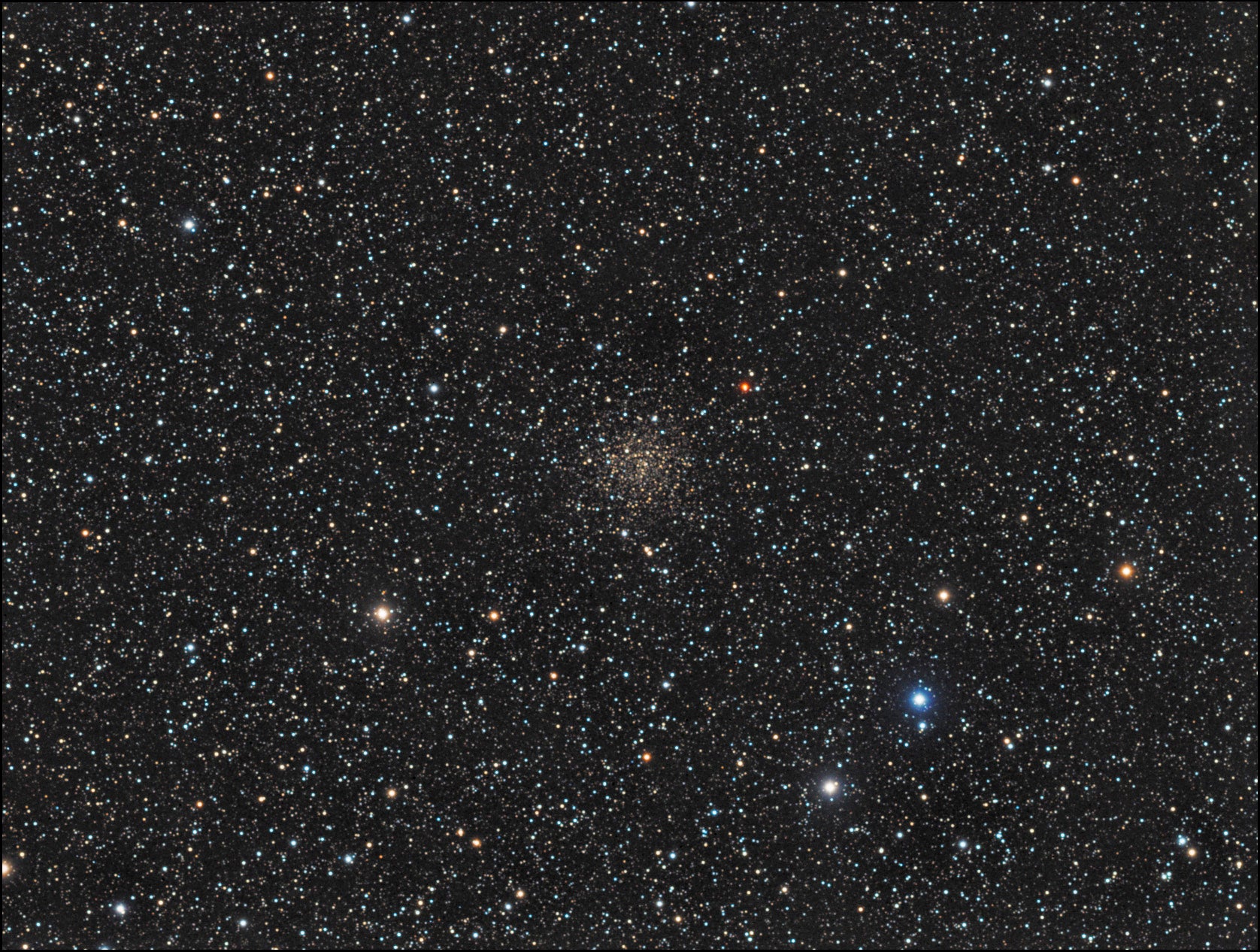
NGC 6791 in Lyra is challenging: At approximately 13,800 light-years away, it is a dim magnitude 9.5. It is compact, resembling a poor globular cluster. This is the most distant cluster of those in this article. With its low surface brightness, tackling this target from anything but a dark-sky site may lead to disappointment. A 12-inch at moderate power is a good start; however, if the transparency is excellent, NGC 6791 should be visible in smaller instruments, even if detail isn’t good. This cluster is about 8 billion years old and many of its stars contain anomalously large amounts of metals (elements heavier than helium) — an astronomical paradox, since older stars are normally metal-poor.
NGC 6819 lies about 60 percent of the way along a line running from Vega to Sadr (Gamma [γ] Cygni), closer to Sadr. At magnitude 7.3, it is visible in a small telescope, though the star count increases significantly between 6-inch and 10-inch apertures. Two lines of stars form an hourglass shape with the greatest density in the middle. This moderately rich cluster is located 9,000 light-years away and is about half the age of the Sun.
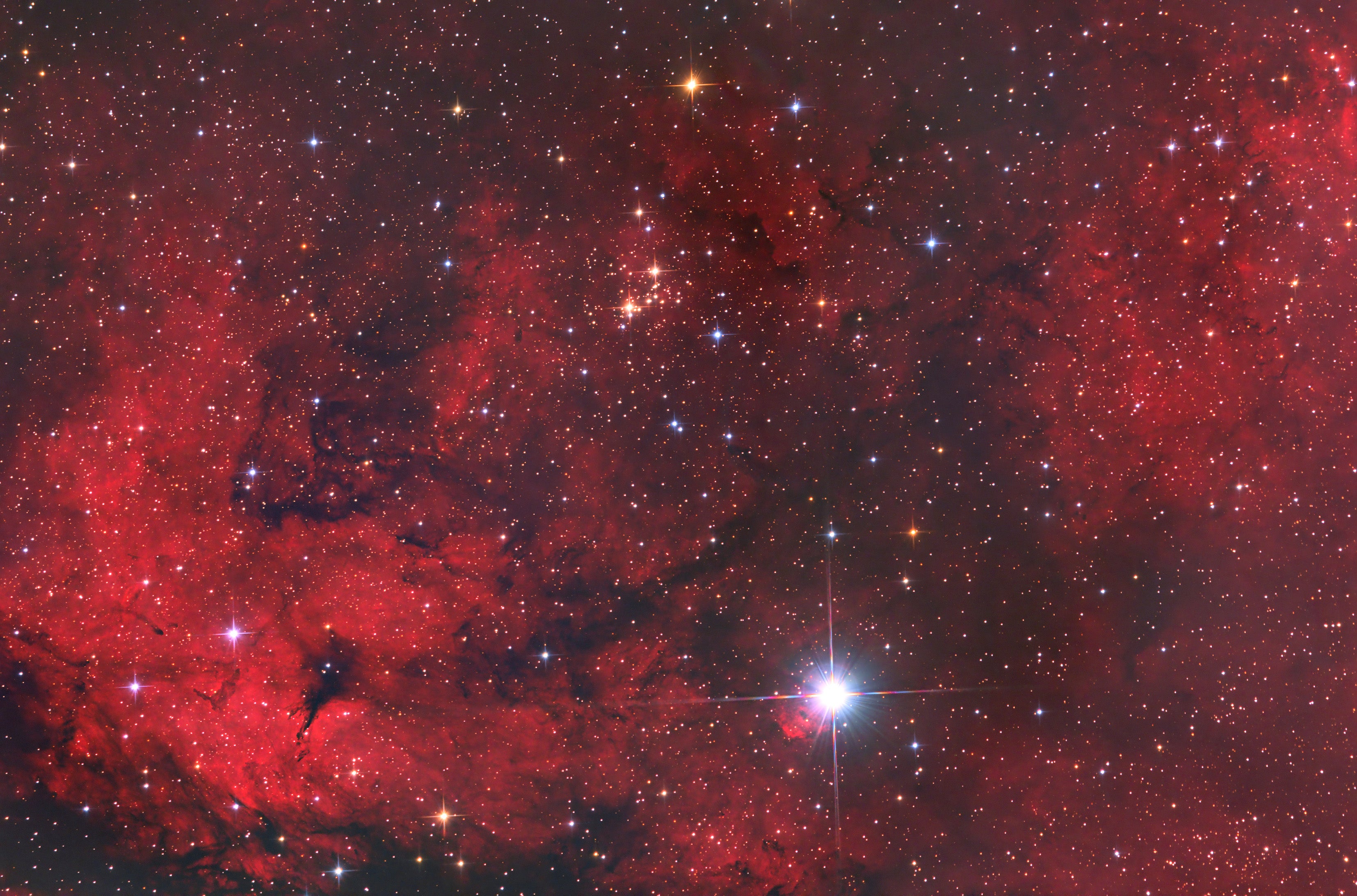
NGC 6910 sits 0.5° north of Sadr, making it one of the easiest clusters in Cygnus to locate. At magnitude 7.5, this Y-shaped group is poor, with about twenty 9th-magnitude stars visible in 6- to 8-inch instruments. It contains about 70 members and is situated in the midst of a complex cloud of hydrogen and dust, the brightest parts of which are designated IC 1318. It forms the core of the Cygnus OB9 Association and is located 5,600 light-years from us.
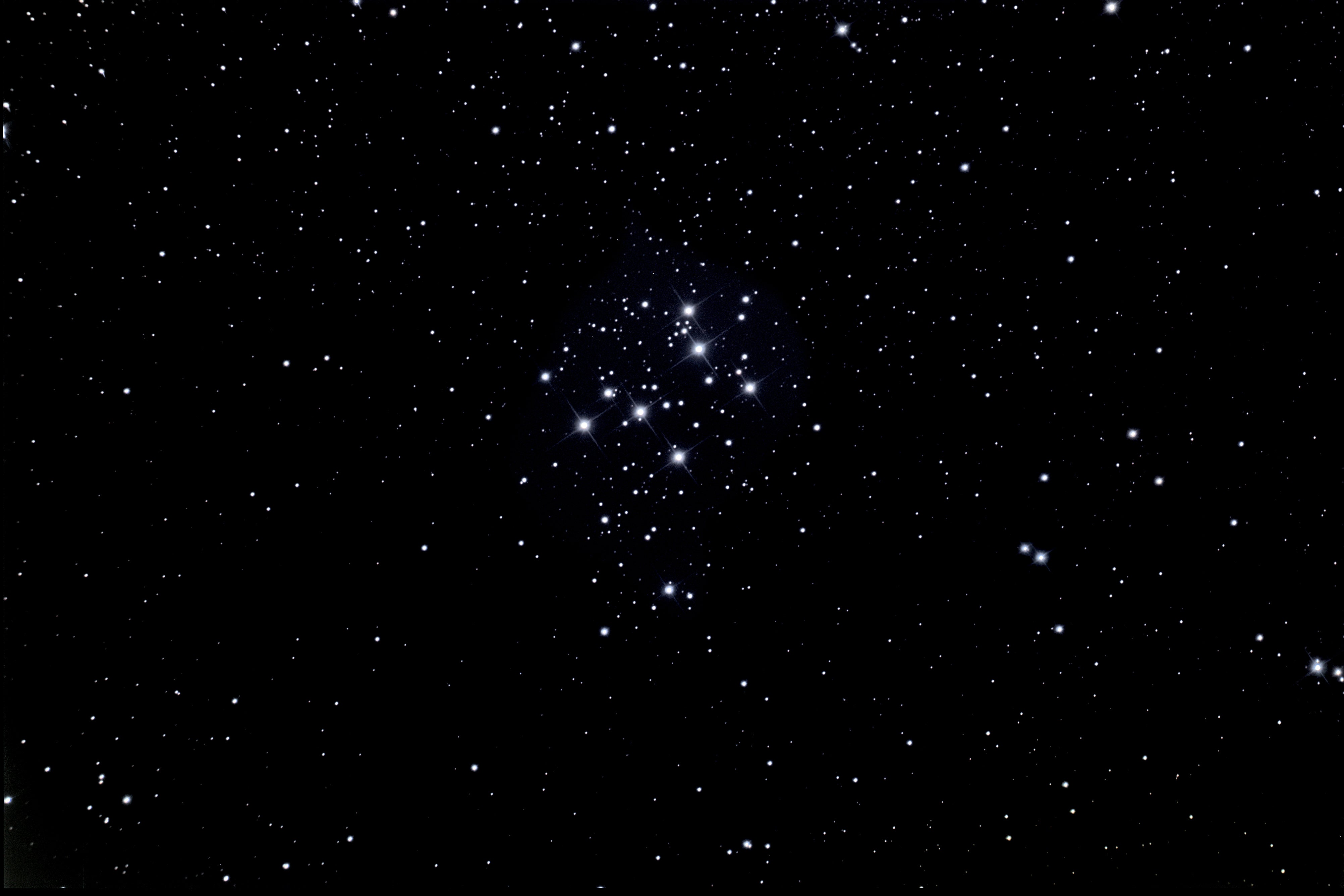
M29 (NGC 6913) is one of two Messier objects in Cygnus. The other, M39, lies outside the Summer Triangle. While M29 is one of the brighter clusters in the area at magnitude 6.6, it’s poorly populated, with only about 50 to 80 members. At an estimated 10 million years in age, it is also one of the younger clusters in the sky. M29 is part of the Cygnus OB1 Association, an aggregate of very luminous B-type stars. (Think Rigel in Orion.) Dust clouds in the region have dimmed these blue giants considerably; otherwise they would form a bright naked-eye object even at their distance of some 5,200 light-years. The cluster is a mere half-degree from the galactic plane.
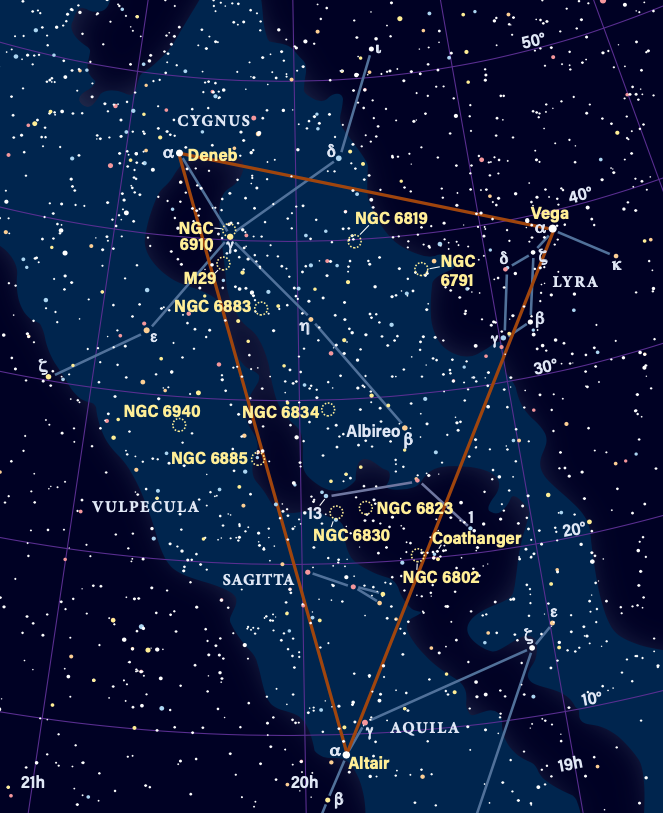
NGC 6883 in Cygnus has about two dozen 8th-magnitude stars within an area roughly 11′ across. If this group was located far from the richness of the Milky Way, it would be easier to observe. Instead, it is about 1° from the galactic plane, in an area rife with foreground and background stars. This makes it challenging to distinguish NGC 6883’s members from the clutter. A 9th-magnitude double star forms the center, with 7th- to 9th-magnitude stars scattered around it. The emission and dark nebulae surrounding the cluster make it a wonderful target for astrophotographers. NGC 6883 is about 4,500 light-years distant.
NGC 6834 can be found about 5° east-northeast of Albireo (Beta [β] Cygni). At 10,700 light-years away, this magnitude 7.8 group is dimmed by interstellar dust. The cluster is visible in a good finder scope or binoculars; look for 25 stars in an area 6′ across. As clusters go, NGC 6834 is young — somewhere around 65 million years old. If the cluster isn’t a challenge for you, scan for the planetary nebula NGC 6842, located 38′ to the east-southeast. It’s got a low surface brightness, requiring optics larger than 12 inches and a really good night to be seen well.
NGC 6885 lies at the very edge of the triangle. It surrounds 6th-magnitude 20 Vulpeculae in a rough oval, with more members to the west. In an 8-inch scope, 30 stars cover an area about 15′ across. This cluster is a bit of a curiosity. Open cluster NGC 6882 is a slight concentration of faint stars within the same field, just northwest of NGC 6885. Some references consider NGC 6882 a duplicate observation of NGC 6885 by William Herschel, though modern catalogs indicate they are separate. Johann Bayer’s Uranometria notes NGC 6882 as slightly concentrated, while NGC 6885 is not. What do you see?
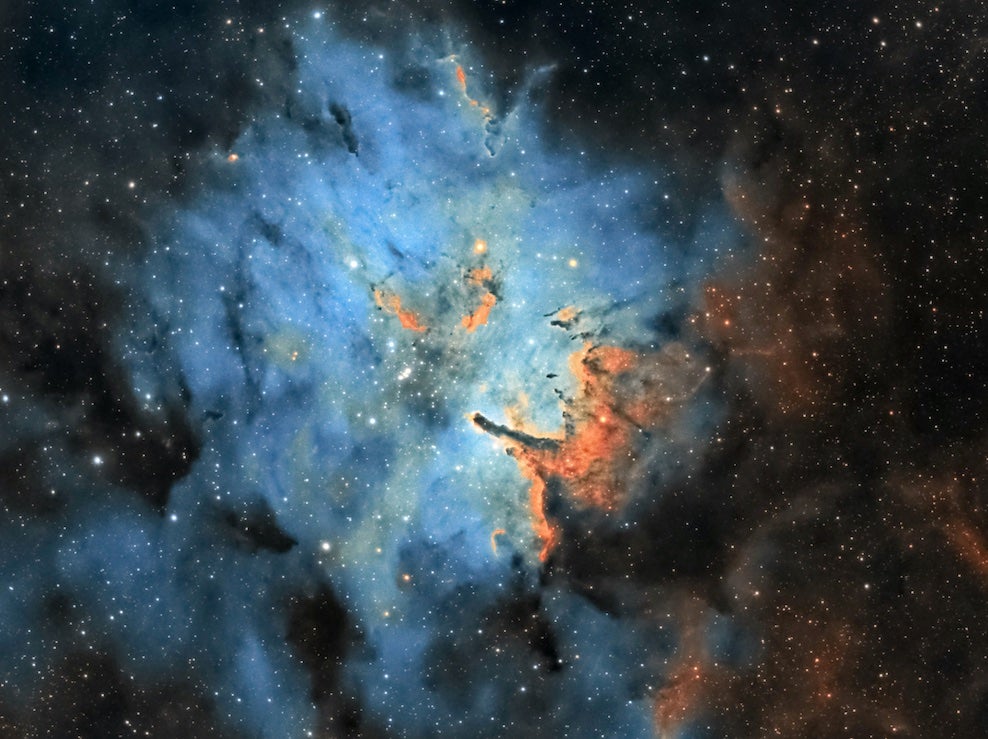
NGC 6823 in Vulpecula is a magnitude 7.1 galactic cluster with 30 stars about 9th magnitude and fainter. Also known as the Vulpecula OB1 Association, it’s a concentration of very young, very hot stars. The group is embedded in an emission nebula with a low surface brightness, known as Sh 2–86. Nearby is the small reflection nebula NGC 6820. Hubble photos show a region resembling the Pillars of Creation in the Eagle Nebula, as stellar winds sculpt the hydrogen cloud and reveal trunks and globules of dust. Located about 7,600 light-years away, the group spans about 50 light-years but appears only 12′ across in your eyepiece.
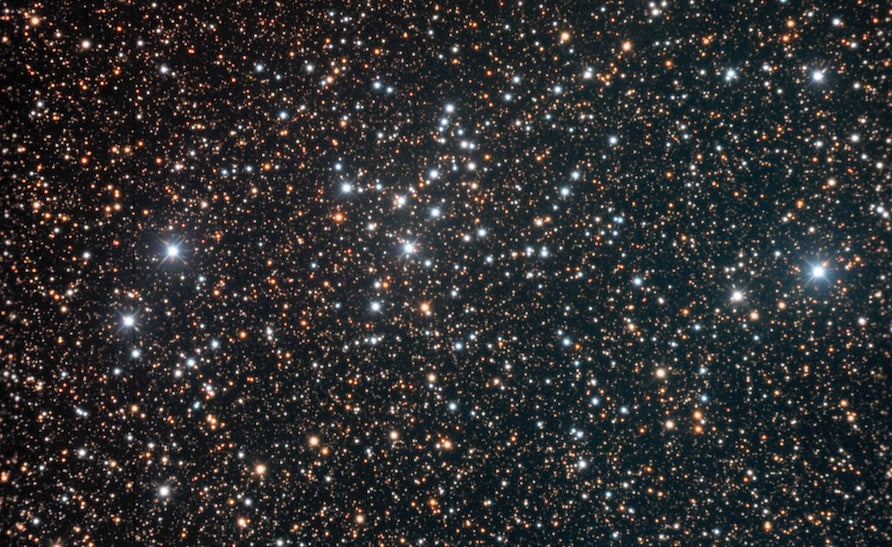
NGC 6830, also in Vulpecula, is about 2° west-northwest of the Dumbbell Nebula (M27). This faint cluster (magnitude 7.9) is about 7,800 light-years away. The brightest stars form an X. Fainter members are best seen under skies with minimal light pollution, using a 10-inch or larger telescope.
NGC 6802 is the richest cluster on this list — though there isn’t much to see in smaller telescopes. At magnitude 8.8 it is extremely easy to find, located on the eastern edge of the Coathanger asterism. Try using an 8- to 12-inch telescope to see the compact 3′-diameter group well. The brightest members are just brighter than 13th magnitude. NGC 6802 has an unusual box shape aligned north-south. It lies about 9,000 light-years away, making it one of the more distant targets on our list.
NGC 6940 in Vulpecula is not inside the Summer Triangle, but is an honorable mention because it lies closer to Earth and shines brighter than any cluster on this list. It contains over 100 stars at 9th magnitude or fainter filling an area about 25′ across. Look for a number of close multiple stars within the cluster. How many of the red giant members can you see? The brightest, FG Vulpeculae, varies from magnitude 9 to 9.5 every 86 days. This cluster lies about 3.5° southwest of the Veil Nebula, a spectacular supernova remnant.
The Summer Triangle offers many wonderful objects to observe. Once you’ve enjoyed its open clusters, there are myriad choices to continue your exploration. Large numbers of double and multiple stars, of which Albireo is the most famous, reside in this great asterism. Wide-field apertures will show numerous star-forming nebulae. Dark nebulae counter the sparkle of stars and the glow of hydrogen gas. And if you tire of stellar birthplaces, look for geriatric suns, as planetary nebulae abound.
From star birth to death and darkness to light, the Summer Triangle has it all.

